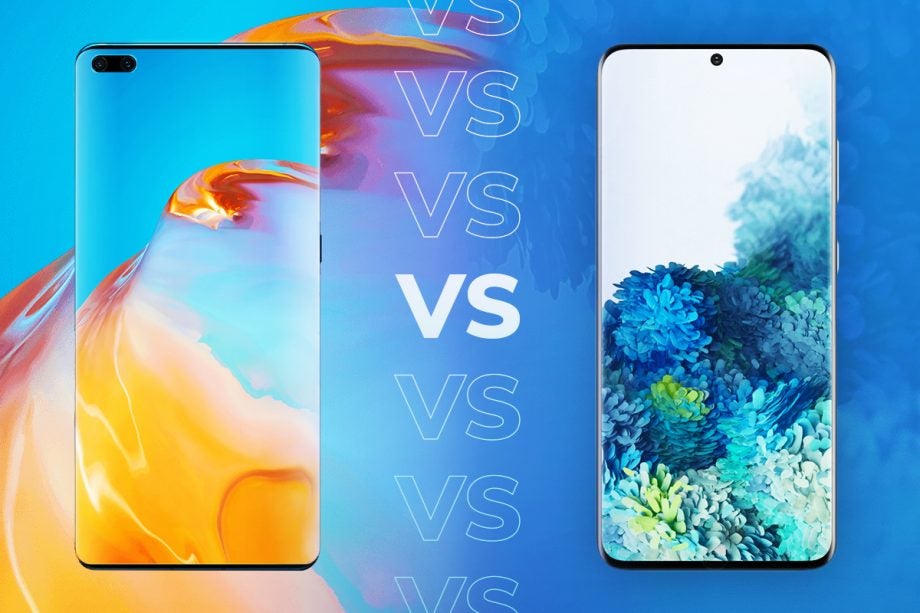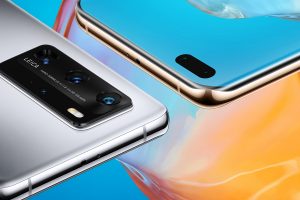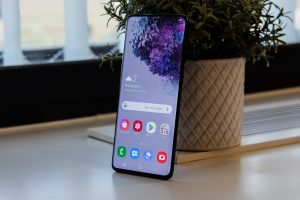Huawei P40 vs Samsung Galaxy S20: Comparing the Android flagships

The Huawei P40 is finally here, joining the Samsung Galaxy S20 as one of the biggest Android phones you can buy in 2020.
We absolutely loved the Huawei P30 Pro, recommending it thoroughly as one of the best Android phones you could buy. So it’s not surprising we’re very excited about its followup.
The Huawei P40 series (which consists of P40, P40 Pro and P40 Pro Plus) comes just a short while after the Samsung Galaxy S20 series (S20, S20 Plus and S20 Ultra) and it’ll no doubt want to take the crown from Samsung when it comes to which Android phone to choose.
Read on for a look at how these phones compare, including a look at the specs, design, camera and more. We’ll be covering all the main features of all the phones in each series. Once we’ve reviewed all the devices, we’ll add a final verdict at the bottom.
If you’re curious how the P40 compares to other flagship phones, make sure to also check out one of our versus guides.
- Huawei P40 vs iPhone 11
- Huawei P40 vs Huawei P40 Pro
- Huawei P40 vs Huawei P30
- Huawei P40 vs Huawei P40 Pro Plus
Huawei P40 vs Samsung Galaxy S20 – Design and screen
The Samsung Galaxy S20 is a nice looking phone, even if it does look very much like every other flagship Samsung phone from the last few years. The screen isn’t curved this time around – a plus for us – but you’ll still find lots of glass and a slightly curved back. Both the S20 and S20 Plus are near-identical aside from the Plus having a larger screen, whereas the Ultra is bulkier and has a huge camera housing on the back.

P40 Pro
While Samsung has lessened its curves, Huawei has doubled-down on them. All models of the P40 series not only have slightly curved edges but a curved top and bottom too – giving it a distinctive look. We’ll have to spend a lot longer with the phones to see whether this makes it harder, or easier, to use.
Huawei certainly has it won when it comes to colours and materials. You can get the P40 Pro Plus in either white or black ceramic, while the P40 Pro can be picked with the nice-looking matte glass rear in various colours. The Galaxy S20 has a single finish – which is very shiny – and less choice in colour. You can get the S20 and S20 Plus in blue, pink and black (these might vary by region) while the Ultra comes in grey or black.
In terms of screen sizes here they are for all the devices:
- Galaxy S20 (6.2-inches), Galaxy S20 Plus (6.7-inches) and Galaxy S20 Ultra (6.9-inches)
- Huawei P40 (6.1-inches), Huawei P40 Pro (6.58-inches), Huawei P40 Pro Plus (6.58-inches)
All the Samsung Galaxy S20 devices have a QHD+ OLED display, with support for 120Hz (as long as you dial down the resolution down to FHD+) and HDR. All the Huawei phones also have OLED panels and an FHD+ resolution, while the P40 Pro and P40 Pro Plus have 90Hz refresh rates. HDR is also supported across the range.
All the phones in both the Galaxy S20 series and Huawei P40 series have an IP68 rating, apart from the regular P40 which misses out on that feature. None of them has a headphone jack.
- Huawei P40 Pro review: Hands on

Samsung Galaxy S20 Plus screen
Huawei P40 vs Samsung Galaxy S20 – Specs and camera
Both these phones are packed with tech. The Samsung Galaxy S20 Plus and S20 Ultra are 5G, whereas there’s a 5G option for the S20 too. All of Samsung’s new flagships are powered by the Snapdragon 865 chipset or the Exynos 990 chipset, depending on your region. RAM ranges from 8GB to 16GB (Ultra only), and storage options go from 128GB to 512GB along with microSD expansion.
We’re a little in the dark over RAM and storage for the P40 series, though we do know it’ll be powered by the 5G version of the Kirin 990 chip.
Huawei’s marketing the camera tech as the P40’s main selling point, however, the specific sensor arrangement you get between the regular P40, P40 Pro and Plus differs.
All three phones boast a new custom 50-megapixel main sensor, co-engineered with Leica. It features an f1.9 lens with OIS and the same custom RYYB colour capture arrangement as Huawei’s 2019 flagships. Both the P40 and Pro combine the main 50-megapixel sensor with a 40-megapixel ultrawide and 12-megapixel hybrid periscope/telephoto lens.
The big difference between the P40 and P40 Pro is that the latter has a ToF sensor for aiding portrait photography.
The Pro Plus consists of a main 50-megapixel sensor with 8-megapixel periscope, 8-megapixel optical telephoto parts and the same 40-megapixel ultrawide seen on its cheaper siblings.
Samsung is also selling the S20 series, and the S20 Ultra especially, on the skill of its camera. Here’s a quick rundown of the camera specs for the S20 series:
- Galaxy S20: 12MP, 64MP tele, 12MP ultra-wide,
- Galaxy S20 Plus: 12MP, 64MP tele, 12MP ultra-wide, ToF
- Galaxy S20 Ultra: 108MP main, 48MP tele, 12MP ultra-wide, ToF
You can shoot 8K video on the S20 series, something not offered by Huawei on the P40 line.
Huawei P40 vs Samsung Galaxy S20 – Software
The Huawei P40 series is shaping up rather well, but there is one area that might be harder for some to swallow. While it does run Android, it doesn’t come with the required services to Google Play, and as such, you miss out on apps like YouTube and Google Pay. It also means you won’t have support, currently, for banking apps and even official builds of Netflix and Uber.
Instead, there’s the growing App Gallery, getting apps via APKs online or other stores like the Amazon App Store.
The S20 series, on the other hand, runs regular Android but with the brand’s One UI 2.1 overlay.
Huawei P40 vs Samsung Galaxy S20 – Battery life
We weren’t too impressed with the battery life from the 5000mAh cell on the Galaxy S20 Ultra. However, we did fare better with the 4500mAh S20 Plus and the 4000mAh S20.
All three phones support 25w fast charging and can go from 0-100% in about an hour. Wireless charging is here too, as is reverse wireless charging.
We’ve yet to review the P40 range so we can’t say for sure how well they’ll last. In terms of specs, the Huawei P40 Pro and Pro Plus both have a 4200mAh battery with 40w wired and wireless charging. The P40 has no wireless charging, cabled charging at 22.5w and a 3800mAh battery.


